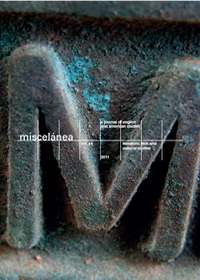“Big Empty Negroes” and “Gay, Exciting” Mexicans: Recontextualizing Fellaheen Identities in Jack Kerouac’S On The Road
DOI:
https://doi.org/10.26754/ojs_misc/mj.20119088Palabras clave:
Jack Kerouak, The Subterraneans, Fellaheen, Raza, GéneroResumen
El término ‘Fellaheen’ se utiliza en On the Road para referirse a grupos étnicos marginados. Mi artículo estudia las construcciones de la identidad Fellaheen, indagando en las representaciones raciales y de género dominantes en la América de los cincuenta. El artículo defiende que la percepción de los Fellaheen por parte de los personajes principales está influida por la diseminación y la reproducción de estereotipos raciales y de género a través de prácticas culturales dominantes en la América de la Guerra Fría. Kerouac aborda los prejuicios de su tiempo y explora su impacto a nivel individual y, por implicación, nacional, y finalmente cuestiona su validez. Teniendo como foco de atención la preocupación de la novela por los personajes afro-americanos y nativos americanos, me propongo examinar las estrategias textuales que cuestionan y, en última instancia, ponen al descubierto lo absurdo de las premisas que condicionan la reproducción de imágenes estandarizadas de lo exótico. En particular, me centro en explorar los temas de género en la novela, abordando también el proceso de colonización que parece operar, y, posteriormente, analizo las estrategias de resistencia narrativa en On the Road.Descargas
Referencias
Ashcroft, Bill, Gareth Griffiths, and Helen Tiffin. 1989. The Empire Writes Back: Theory and Practice in Post-Colonial Literatures. London: Routledge.
Baudrillard, Jean. 1983. Simulations. Trans. Paul Foss, Paul Patton and Philip Beitchman. New York: Semiotext(e).
Bhabha, Homi. 1994. The Location of Culture. London: Routledge.
Brinkley, Alan. 2001. “The Illusion of Unity in Cold War Culture”. In Kuznick, Peter and James Gilbert (eds). Rethinking Cold War Culture. London: Smithsonian Institution Press: 61-73.
Brinkley, Douglas (ed.) 2004. Windblown World: The Journals of Jack Kerouac 1947-1954. New York: Viking-Penguin.
Charters, Ann (ed.) 1995. Selected Letters of Jack Kerouac: 1940-1956. London: Viking-Penguin.
Cunnell, Howard. 2007. “Fast This Time: Jack Kerouac and the Writing of On the Road”. On the Road: The Original Scroll. New York: Viking-Penguin: 1-52.
Douglas, Ann. 1998. “Periodizing the American Century: Modernism, Postmodernism, and Postcolonialism in the Cold War Context”. Modernism/Modernity 5: 3 (September): 71-98.
Ehrenreich, Barbara. 1983. The Hearts of Men: American Dreams and the Flight from Commitment. Garden City New York: Anchor Pr. Doubleday.
Ellis, R.J. 2006. “Scandalous for Being Scandalous: ‘Monstrous Huge Fuck[s]’ and ‘Slambanging Big Sodomies’ in Jack
Kerouac’s On the Road”. In Morrison, Jago and Susan Watkins (eds.) Scandalous Fictions: The Twentieth-Century Novel in the Public Sphere. Basingstoke, England: Palgrave Macmillan: 99-116.
“Fellah.” The Merriam-Webster Online Dictionary. 2009. Merriam-Webster Online. <http://www.merriam-webster.com/dictionary/fellah>. Accessed 19 January, 2009.
Gane, Mike. 2000. Jean Baudrillard: In Radical Uncertainty. London: Pluto Press.
Gewirtz, Isaac. 2008. Beatific Soul: Jack Kerouac on the Road. New York: The New York Public Library.
Gilbert, James. 2005. Men in the Middle: Searching for Masculinity in the 1950s. Chicago: University of Chicago Press.
Hebdige, Dick. 1979. Subculture and the Meaning of Style. London: Methuen.
Hill, Geoffrey B. 2005. “A Well Travelled Road: The Figure of the Minstrel in Jack Kerouac’s On the Road”. In Wright, Will and Steven Kaplan (eds.) The Image of the Road in Literature, Media, and Society. Pueblo, CO: Colorado State University-Pueblo: 144-147.
Holton, Robert. 1999. On the Road: Kerouac’s Ragged American Journey. New York: Twayne Publishers.
Huggan, Graham. 2001. The Postcolonial Exotic: Marketing the Margins. London: Routledge.
Kerouac, Jack. 2006. Book of Sketches. London: Penguin.
—. (1959) 2001. Doctor Sax: Faust Part Three. London: Flamingo.
—. (1957) 2000. On the Road. London: Penguin.
—. 2007. On the Road: the Original Scroll. In Cunnell, Howard (ed.) New York: Viking-Penguin.
Lardas, John. 2001. The Bop Apocalypse: The Religious Visions of Kerouac, Ginsberg, and Burroughs. Urbana: University of Illinois Press.
Leland, John. 2007. Why Kerouac Matters: The Lessons of On the Road (They’re not What You Think). New York: Viking.
Ligairi, Rachel. 2009. “When Mexico Looks like Mexico: the Hyperrealization of Race and the Pursuit of the Authentic”. In Holladay, Hillary and Robert Holton (eds.) What’s your Road, Man? Critical Essays on Jack Kerouac’s On the Road. Carbondale: Southern Illinois U.P.: 139-154.
Martinez, Manuel Luis. 1998. “‘With Imperious Eye’: Kerouac, Burroughs, and Ginsberg on the Road in South America”. Aztlán: A Journal of Chicano Studies 23: 1 (Spring): 33-53.
Richardson, Mark. 2001. “Peasant Dreams: Reading On the Road”. Texas Studies in Literature and Language 43 (2): 218-42.
Rose, Lisle A. 1999. The Cold War Comes to Main Street: America in 1950. Lawrence: University Press of Kansas.
Saldaña-Portillo, María Josefina. 2002. “‘On the Road’ with Che and Jack: Melancholia and the Legacy of Colonial Racial Geographies in the Americas”. New Formations: A Journal of Culture/Theory/Politics 47 (Summer): 87-108.
Spengler, Oswald. 1980. The Decline of the West. Trans. Charles Francis Atkinson. 2 vols. New York: Alfred A. Knopf.
Swartz, Omar. 1999. The View from On the Road: The Rhetorical Vision of Jack Kerouac. Carbondale: Southern Illinois U.P.
Theado, Matthew. 2009. “Revisions of Kerouac: The Long, Strange Trip of the On the Road Typescripts”. In Holladay, Hillary and Robert Holton (eds.) What’s your Road, Man? Critical Essays on Jack Kerouac’s On the Road. Carbondale: Southern Illinois U.P.: 8-34.
Descargas
Publicado
Número
Sección
Licencia

Esta obra está bajo una licencia internacional Creative Commons Atribución-NoComercial 4.0.


